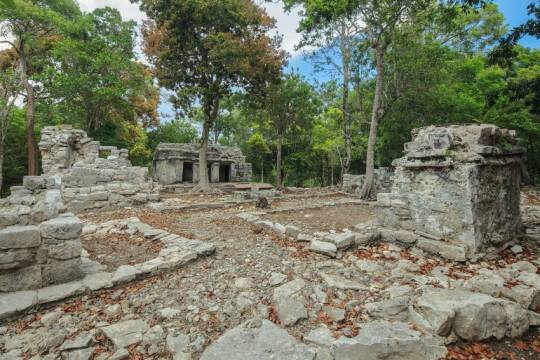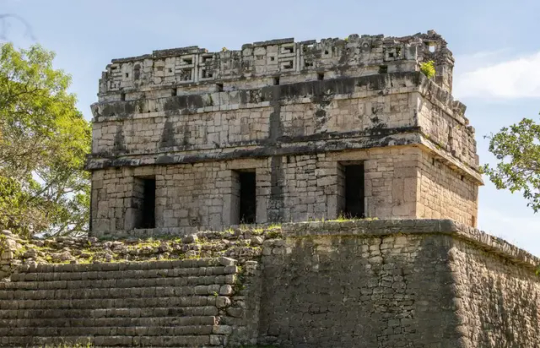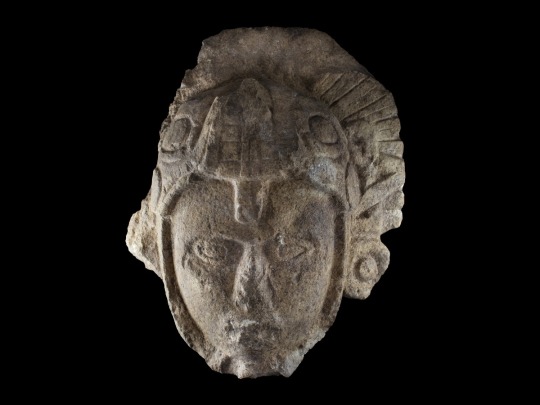#Maudslay’s Temple 6
Explore tagged Tumblr posts
Text

Archaeologists Find Maya Warrior Head Sculpture in Mexico
Archaeological rescue work ahead of the Maya Train construction has turned up another remarkable find in Chichén Itzá – a well-preserved sculpture of a Maya warrior head in a helmet shaped like a feathered serpent with open jaws.
The head was discovered on Tuesday in Maudslay’s Temple 6, in the Casa Colorada complex of Chichén Itzá, in Yucatán, as part of the Program for the Improvement of Archaeological Zones (Promeza).
The 33 centimeter-high sculpture appears to date from the earliest period of habitation of Chichén Itzá.
“It was customary to represent warriors with a headdress, with a kind of helmet,” he said. “In this case it is a snake figure from which the face of this character emerges, and a feathered headdress, so it is probably alluding to Kukulcán, the feathered serpent of the Maya.”
Just last week, INAH archaeologists discovered a circular temple dedicated to Kukulcán at the El Tigre site in Campeche, also as part of Promeza works associated with the Maya Train construction.
Prieto Hernández used his presentation at the morning press conference to give updates on other Promeza projects, including conservation work at the Xelhá site on the coast of Quintana Roo.
The site is around 1,300 years old, and its name means “Entrance to the Water” in the Mayan language. It was the principal port of the Cobá kingdom in the years 250-600 A.D., but fell into rapid decline after diseases introduced by the Spanish conquest all but wiped out the native inhabitants.
Prieto Hernández insisted that Promeza projects are helping to give today’s Maya communities new contact with their past – although the Maya Train has also been controversial among Indigenous communities for its impact on the natural environment and their way of life.
As of Nov. 9, Prieto Hernández said that archaeological salvage work on the seven sections of the Maya Train had recovered 57,146 building structures, 1,925 movable artifacts, 660 human burials and 2,252 natural features associated with human settlements.


#Archaeologists Find Maya Warrior Head Sculpture in Mexico#Chichén Itzá#Maudslay’s Temple 6#sculpture#stone sculpture#ancient artifacts#archeology#archeolgst#history#history news#ancient history#ancient culture#ancient civilizations#Maya history#Maya art
63 notes
·
View notes
Text

Maya Statue Head,
On Tuesday, November 7, archaeologists in the eastern Yucatán Peninsula unearthed a well-preserved Maya warrior statue head adorned with a serpentine headdress amidst construction for the Maya Train.
Measuring approximately 13 inches tall and 11 inches wide, the artifact was found during the excavation of a wall in Maudslay’s Temple 6, a site named after the British archaeologist Alfred Maudslay within the Casa Colorada Complex in the Maya city of Chichén Itzá. The complex is one of four buildings surrounding the main plaza of the ancient site.
The object may date back to the earliest years of Chichén Itzá, founded around 455 CE.
#art#history#design#style#archeology#sculpture#maya#statue#head#chichen itza#warrior#snake#yucatan#kukulkan#god#feathered serpent
21 notes
·
View notes
Photo

#REPOST @megalithicmarvels with @get__repost__app TOP 10 PHOTOS OF 2021 2021 was a great year of research and exploration regarding megalithic structures and ancient civilizations. From the hundreds of photos posted this year, here are the top 10 based on total impressions: 1. (1.1M impressions) Cut from a single massive rock, India’s Kailasa Temple is the largest of 34 temples that make up the Elora Caves complex. 📷 by @kunaldalui 2. (728K impressions) Evidence of lost ancient technology seen up close in the megaton walls of the mysterious Osirion of Abydos archaeological site. 📷 by @ Gord Tiemstra 3. (560K impressions) Compelling evidence of lost ancient technologies seen at Saqqara. 📷 @aturstravel 4. (473K impressions) Vintage photo of the Serapeum of Saqqara - which holds one of the great mysteries of Egypt - the 25 black precision crafted granite boxes weighing approx 100 tons each. 📷 by (unknown) 5. (469K impressions) With a Spanish Monastery built on top of it in the 1600s, Cusco’s ancient Coricancha (The Golden Temple) features astonishing megalithic precision & was considered the jewel of the Inca empire… but did it predate the Inca? 📷 @ Julien Coqueret 6. (435K impressions) Catalunya, Spain: a large stone with what appears to be four ancient, yet precision cut core-drill holes. 📷 @ Jorge Jose Manuel Bernal 7. (434K impressions) Izabal, Guatemala 1894: the largest of the three-dimensional Maya zoomorphs found at the Quirigua archaeological site which weighs 20 tons. 📷 by @ Alfred P Maudslay 8. (409K impressions) Cusco is a city made of a million #megalithicmarvels 📷 by @enigma.cusco 9. (374K impressions) Sunlight glows on India’s Lakshmana Temple, an architectural masterpiece 📷 by @the.artographer 10. (361K impressions) Cut straight from the ancient stone crevices, it is estimated that 85% of Petra has yet to be uncovered. 📷 by @emmett_sparling (à Abydos Temple, Abydos, Egypt) https://www.instagram.com/p/CX-zC7jqI4o/?utm_medium=tumblr
2 notes
·
View notes
Text
Image from page 244 of “Annual report of the Bureau of American Ethnology to the Secretary of the Smithsonian Institution” (1895)
Identifier: annualreportofbu219smit Title: Annual report of the Bureau of American Ethnology to the Secretary of the Smithsonian Institution Year: 1895 (1890s) Authors: Smithsonian Institution. Bureau of American Ethnology Subjects: Smithsonian Institution. Bureau of American Ethnology Ethnology Indians Publisher: Washington : U. S. Govt. Print. Off. Contributing Library: Boston Public Library Digitizing Sponsor: Kahle/Austin Foundation and Omidyar Network
View Book Page: Book Viewer About This Book: Catalog Entry View All Images: All Images From Book
Click here to view book online to see this illustration in context in a browseable online version of this book.
Text Appearing Before Image: ers here to the date to be supplied, as has been shown,to the third series on the right slal) of the Tablet of the FoliatedCross. The interval he gives betweiMi the two dates is 6-11-6, whichis in accordance with the inscription. Tiiis is fol!owe(l (11) by S Ahau8 Lo with an interval of 1-12-4. whicli is also correct. TEMPLE OK INSCKIITIONS 771 ]t will l)t seen from this discussion that tlicri arc some ln-caks in hissynopsis which \ ill. until Ihcv aiv cxpltiinctl. icaxc it in an unsatisfac-tory coudition. Nc(rth(^less. as has l)eon suyycstcd. the two inscrip-tions appear to he based on the same enetit of Mr Maudslays photo-graphs and drawings and, to some extent, of Mr Cioodmans interpre-tation. As parts of the inscrijition have lieen badly defaced it is
Text Appearing After Image: Flii. 1^—Ijiit ol the illsuriplian uii tiic wall ul thu Tumpk- ^ti InscriiJtiuiis, Puluiiqiiu. impossible to give the series and dates iu connected form. Attentionwill therefore be directed only to such portions as are sufficiently dis-tinct to be determined with probable coriectness ))y inspection. AsMr (xoodmaii has given, on i)ago ll-t of his work, a copy of part of theinscription with comments, reference will l)e made tirst to this portion,of which a copy is gi(>n in our tigure 18. This portion is lettered andnuinbered separately in the usual manner. Mr Goodmans conuuents. as given on pages 114 and 115 of his work.are as follows, the breaks and parentheses being his own: The readini: of tlie above, so far as 1 can make it out, in as follows: (To the) 10 Alum 1.1 Yaxkiii (that is) 1 caUinlar roimil (froii; a. or tile samel date appcuriiitr some ilistaiire liaik—S days, it ilmens (^tliere is what 772 MAYAN CALENDAR SYSTEMS [ethannIU appears almost like a trick here: the numb
Note About Images Please note that these images are extracted from scanned page images that may have been digitally enhanced for readability – coloration and appearance of these illustrations may not perfectly resemble the original work.
Posted by Internet Archive Book Images on 2014-07-30 08:47:55
Tagged: , bookid:annualreportofbu219smit , bookyear:1895 , bookdecade:1890 , bookcentury:1800 , bookauthor:Smithsonian_Institution__Bureau_of_American_Ethnology , booksubject:Smithsonian_Institution__Bureau_of_American_Ethnology , booksubject:Ethnology , booksubject:Indians , bookpublisher:Washington___U__S__Govt__Print__Off_ , bookcontributor:Boston_Public_Library , booksponsor:Kahle_Austin_Foundation_and_Omidyar_Network , bookleafnumber:244 , bookcollection:USGovernmentDocuments , bookcollection:bostonpubliclibrary , bookcollection:americana , bookcollection:additional_collections
The post Image from page 244 of “Annual report of the Bureau of American Ethnology to the Secretary of the Smithsonian Institution” (1895) appeared first on Good Info.
0 notes